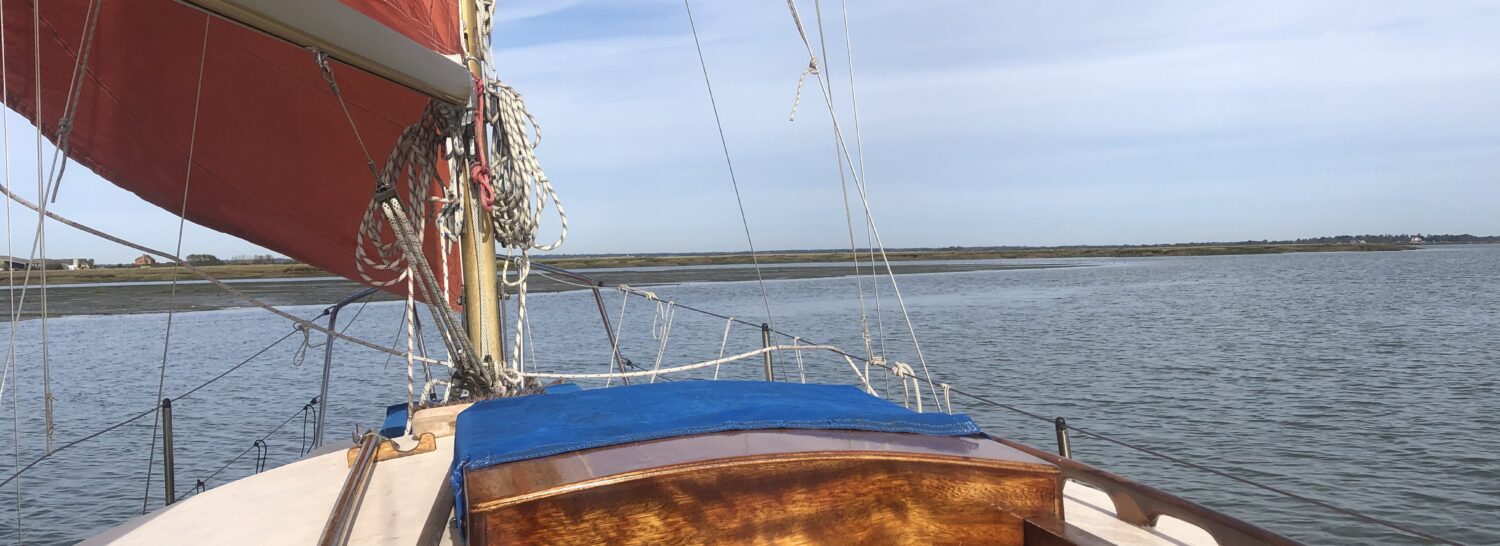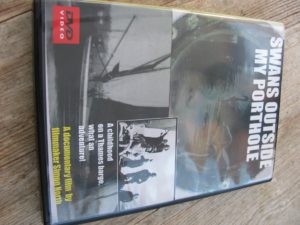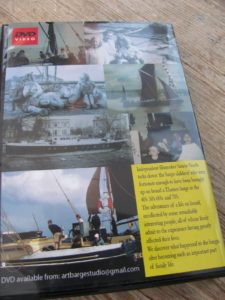Swans outside my Porthole – a film by Simon North.
Simon began this film some years ago now. Whilst other projects have come and gone in the mean time, this film has made it off the cutting table. It is: a wonderful picture of the life of some of the spritsail barges that came out of trade during the late 1940s through to the 1960s, and the people who owned or lived on them.
This was long before the advent of the charter barge, the job that barges have continued to do when the carriage of bulk cargoes eventually ceased. Barges morphed into motorised vessels or were simply dumped along the foreshore. The ‘lucky’ ones sailed on as yachts or sat as ‘humble’ homes. The spritsail barge continues to work on, carrying people, earning a living or simply as a means to defray annual costs.
Simon wanted to look closely at what life was like afloat for the families of owners who purchased an old barge to use as a floating home. Fortunately Simon was able to speak to a number of people who either lived aboard, some of the time, spent part of their lives aboard, or in my case, from birth to running away to get married…
The film. (It was upright before loading…)
The film is a nostalgic trip back in time to a different age, an age devoid of electronic communications and for some, electricity even … it opens with a discussion with Jeremy Larkin who was a school boy (public) when his parents bought the Five Sisters, a little barge of just 76 feet. It was his mother, Peggy, who led this ‘game’ for her husband was away at sea serving in the Royal Navy a lot. It was a career into which Jeremy followed. Their barge was around the size of the Henry, which currently sits ‘mouldering’ alongside Standard Quay in Faversham.
To me, what was clear was that the ‘children’ weren’t around all the time. The barge was sailed to Paris where Jeremy’s father became a Naval Attaché. After being hit by a crane barge during a Seine flood the Five Sisters was badly damaged and soon sold after her return to England.
We then jump to a barge called Montreal, a lighter built in 1902 but rigged out during the 1970s. She finally went ‘upriver’ to a mooring above Battersea. From there she went to Erith c2014 and was broken up as beyond redemption … Simon tracked down owners who lived and sailed a little on her. I was ‘crying out’ for these folk not to keep referring to her as ‘the boat’. A thing I have! But, all the same it was interesting.
My dear wife had begun to chunter by this time for something had struck her – more of this later. I alluded to it earlier.
Cargoes are discussed, including the carriage of coal – Lots Road Power Station sat across the river from Montreal’s berth … and here the barge’s last owner still pines for the river’s aura that he enjoyed during life afloat. Marriage took him off to a fully functioning modern abode, ashore!
Other owners of Montreal and Imogen Stubbs, who spent her early years aboard the Cetus and later on Resourceful , all talked of the camaraderie of the floating communities in which they lived. I would agree with this. Simon briefly touched upon the Cambria, being the last sail trader carrying solid goods.
There is a touching piece when a young lady talks about climbing the rigging of the Montreal behind her father – something she clearly wasn’t supposed to do. It was discussed with great excitement … and I smiled wryly for this was part of my life and that of my siblings from an early age. We were expected to ‘do’!
The back cover with pictures. of barges and families..
After a look at modern sailing barge matches, I was suddenly aware ‘we’ were aboard my Whimbrel sailing off the eastern end of Canvey Island along the edge of the London River’s wide open Sea Reach. Back at the mooring, Simon is soon opening me up on my barging childhood, and that of my siblings.
What struck me was that I was the only one to openly talk, with some humour, of the hardship of endeavouring to keep the May Flower (my floating home) going. The efforts taken by all the family in this task were continuous, but we not only kept her afloat for a little more than thirty years, we kept her sailing for a quarter of a century after her trading life ended.
I sat, fascinated, as I listened to myself discussing the way of life. The ‘responsibilities’ post school. The ‘trades’ we learnt without hesitation. You’ll need to read The May Flower A Barging Childhood to really understand this … what’s not written would fill another volume… The book is still available, being in print continuously for eleven years now.
The May Flower (Blt 1888) remained the oldest sailing barge in sail until superseded by the little Cygnet after her 1970s rebuild. Both were built by Currel of Strood, Kent.
I believe Simon has completed something here that is truly historic. It is a record that will eventually, sooner rather than later, be impossible to tell, for most that experienced this life are aging … none of us can live for ever!
Many in the barge world today live in a world seen through ‘rose tinted glasses’ sailing on vessels that have largely been rebuilt – are certainly in better condition than when carrying their last cargoes. Yes, it is a hard life being a bargeman. But, for most it is a paid job. There is a home to go to and for many barges, come the end of the weekend, the scuttle is locked and she rests alone…
Living aboard a ‘modern’ barge (Thames or ‘Dutch’ type) is often described as idyllic. This permeates a little at times in the film. It certainly wasn’t like this in the early decades Simon covered or that of my own experiences. Yes I have good memories, historic memories. But would I like to do it again. No! I think my siblings would agree!
My wife said, ‘What comes across is how different the Ardley children’s experiences of living aboard a barge was…’
Hmmmmm…
Well done Simon.
The film is available as a cassette CD at: artbargestudio@gmail.com at £15 including p&p, or from Simon’s youtube page, see:
https://youtube.be/YWLRbfDbsyU


